| 1 | Oriental ratsnake |
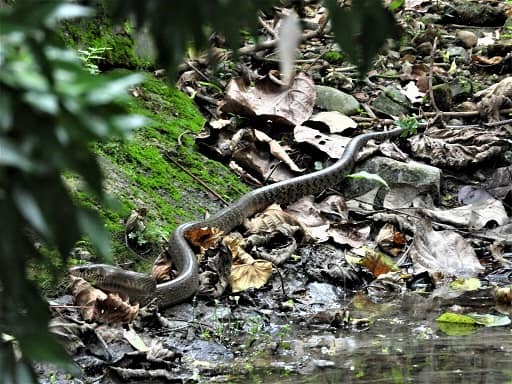
The most abundant large snake in Hong Kong, and the second longest native snake after the king cobra. The oriental ratsnake reaches a brutish 370cm in the largest individuals, with an average of 150-195cm. This species isn’t bothered even slightly by the heavily urbanised nature of Hong Kong. They slither down streets, through gardens, and along stone pavements, searching eagerly for their next meal.
The oriental ratsnake (Ptyas mucosa) is non-venomous, and will normally flee if approached by humans. However, if cornered with no room to escape, they may stand their ground, spread their neck to mimic a cobra, and deliver a painful bite. Oriental ratsnakes are a common presence on Hong Kong’s many jogging trails, and often weave through water culverts searching for frogs, their main prey. They also eat a helping of mammals, and birds such as house sparrows, but amphibians constitute over 50% of their prey, with one favourite in Hong Kong being the Asian common toad (Bufo melanostictus).
Oriental ratsnakes have also been found in roofs in Hong Kong, with their heads poking out of wooden rafters. As they move mainly during the day, they’re encountered regularly by ordinary Hong Kong citizens.
Oriental ratsnakes have multiple skills. They can climb, swim, and blast into the undergrowth at high speeds to equal effect. This species also holds a less welcome record. Snake soup and meat is a booming industry in southeast Asia, especially in China, and in 2011, scientists obtained 16 snake meat samples from shops around Hong Kong. The verdict: oriental ratsnakes were the most common ingredient, with Javan spitting cobras coming second (despite their venom).
| 2 | Greater green snake |
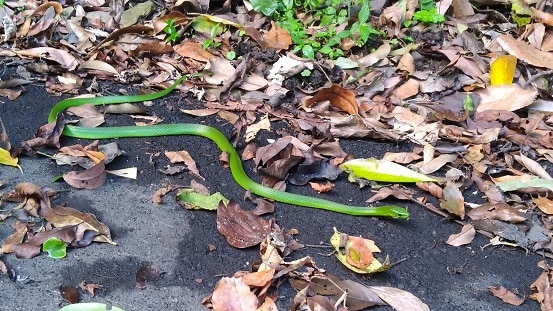
This species belongs to the same Ptyas genus as the oriental ratsnake, yet with their leafy green scales, there’s no chance of confusing them. In fact, the greater green snake (Ptyas major) has a problem its cousin doesn’t: being mistaken for bamboo pitvipers and whacked to death. In reality, this snake is non-venomous, and generally flees into the bushes if frightened, where it can blend in using its superb camouflage.
Greater green snakes have a thin body, and eat a diet of earthworms. Consequently, they can be found anywhere in Hong Kong with soft soils: less likely in a water culvert, but more likely in a meadow, a riverbank, or the soft grassy ground of a playpark.
Greater green snakes are encountered commonly in Hong Kong, and are no threat to humans. They bite people occasionally, but are incapable of doing much damage due to their small mouths. During daytime, they’re usually found on the ground, while at night, they seek refuge on high branches. This snake has round pupils, with a brown-orange iris.
The greater green snake averages at 70-90cm, pushing to a maximum of 130cm. This species is widespread in southeast China, and also reaches northern Laos and Vietnam, but isn’t found in Thailand.
| 3 | White-browed keelback |
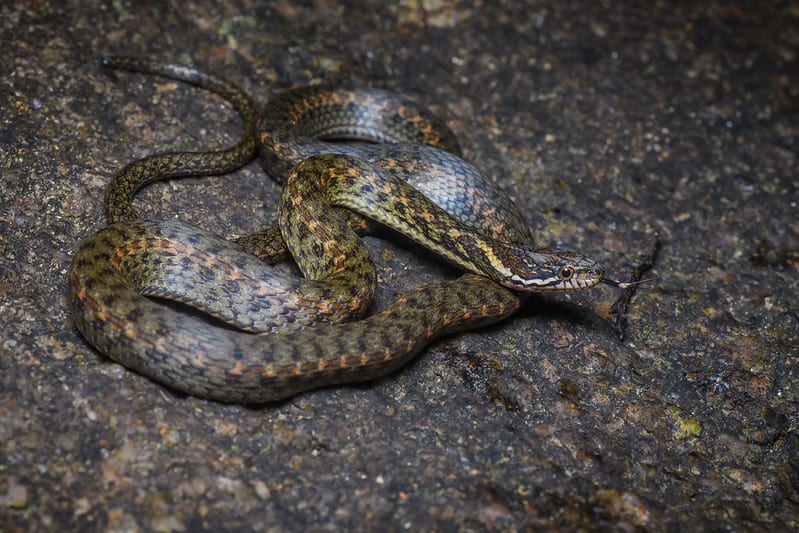
A much rarer species of Hong Kong snake. The white-browed keelback not only moves by night, but avoids inhabited areas. They’re most common near water bodies in forests, such as small rocky streams, and their camouflage is superb.
The white-browed keelback (Hebius boulengeri) has a simple ID sign: a snowy white stripe extending backwards from each eye. They have round pupils with a bronze iris, and a mostly black tongue, but with a white centre. White-browed keelbacks are typically greenish-black with a honey-brown stripe along each flank.
The white-browed keelback reaches a maximum of 88cm. This species is no threat to humans, but is rarely encountered and may possess secret skills. They were once observed with a white dribble of liquid on their neck, which could easily be poisonous (like the tiger keelback of Japan).
When frightened, a white browed keelback will coil into a small ball to protect its brain. When startled, they dart quickly into leafy cover, while if picked up, they usually coil harmlessly around your finger.
White-browed keelbacks have never been observed to bite, and most Hong Kong citizens don’t even know they exist. This species has been recorded eating small amphibians, in rocky stream habitats. Note of confusion: this species is occasionally referred to as Boulenger’s keelback, which is also a separate Sri Lankan species (Fowlea asperrima).
| 4 | Radiated ratsnake |
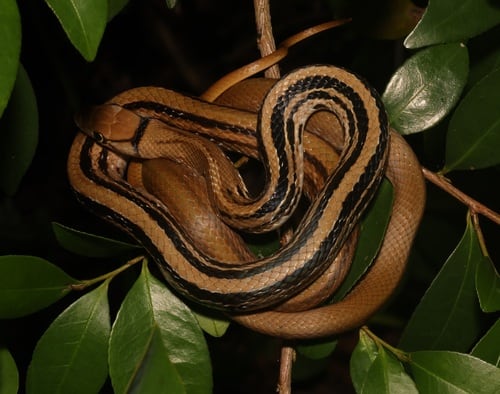
Another common yet (mostly) harmless species. The radiated ratsnake (Coelognathus radiatus) appears in every region of Hong Kong, and has the signature feature of extreme speed. This species can disappear into undergrowth in the blink of an eye, and they also possess an aggressive temperament. They prefer to flee rather than fight, but will strike furiously and deliver slashing bites to your arm if cornered against a wall.
Radiated ratsnakes also have a terrifying defensive display. They bare their mouths like a lunatic and puff their neck up, and with their relatively large eyes, they succeed at intimidation more than most non-venomous snakes.
Radiated ratsnakes move by day, and have beige patterns overlaid with long black stripes, and the occasional white line between scales. They reach a maximum of 230cm, and are usually found in open grassy areas.
Radiated ratsnakes dislike dense forests and misty hills. Consequently, they’re encountered regularly by ordinary Hong Kong citizens, usually without incident. Like the oriental ratsnake, they’re a multi-skilled species which can swim across rivers, climb trees, and slither confidently down pavements.
| 5 | Diamond-backed watersnake |
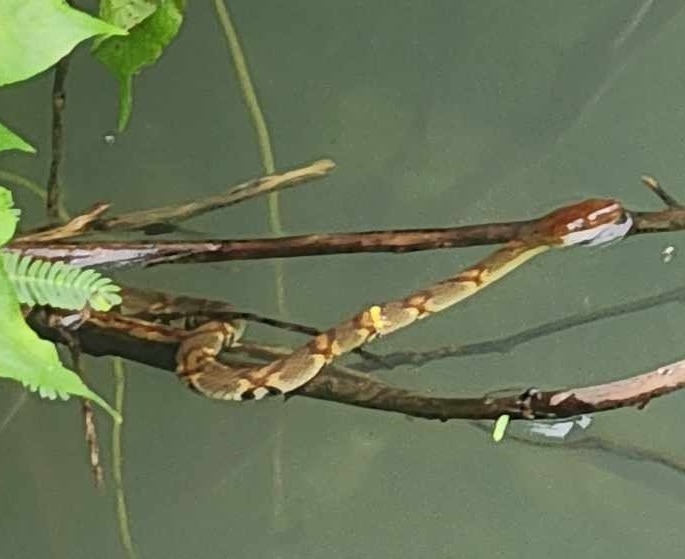
This harmless snake prefers to hang out in rivers, away from the hustle and bustle of Hong Kong’s busy streets. The diamond-backed watersnake (Trimerodytes aequifasciatus) isn’t rare, but will never appear outside a fruit shop or a block of flats. Rather than ponds, they stick to deep bodies of fresh water, such as small lakes or slow-moving tributaries. They’re also decent climbers, and their favourite place to ascend is a branch directly overhanging water, which allows them to leap down when their danger sensors pick up a slight flicker of activity.
This snake varies in appearance, but is usually grey, with brown patterns similar to hourglasses, each with a creamy core. Diamond-backed watersnakes measure up to 142cm, and have a thick body, making them one of Asia’s larger snakes that nobody ever talks about. This species inhabits southeast China, northern Vietnam, and northern Laos, but Hong Kong is a particular base.
Diamond-backed watersnakes are no threat to humans. Their teeth are no joke, but they’re strangely reluctant to use them, and like the brown watersnake of the southern US, they prefer to dive headfirst into water for safety. This snake mainly preys on fish, with the occasional amphibian. They have amber eyes with a round pupil, and a thick set head.
| 6 | Anderson’s stream snake |
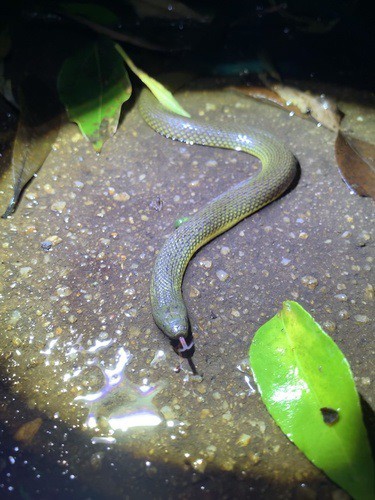
A nocturnal snake, which is common all over Hong Kong. This is a harmless, 30cm average species which often blends into muddy banks because of its muddy brown colours.
Anderson’s stream snake (Opisthotropis andersonii) is completely non-aggressive, and has no desire to harm a human. Though a freak occurrence can’t be ruled out, they rarely bite even if picked up, nor do they squirm frantically. Anderson’s stream snakes particularly favour shallow, rocky rivers, where they can swell to large numbers if conditions are optimal. Their bodies are perfectly adapted to this habitat, with a narrow head that they force between rocks in order to seize shrimp, one of their favourite prey.
Opisthotropis andersonii measures up to 50cm. They also have a liking for earthworms, and immediately after heavy rains, they’ll suddenly appear on trails bordering rivers.
Anderson’s stream snakes have few noticeable patterns, and have a grey-green body with a whitish underbelly. A rocky, slow-moving stream is their absolute favourite habitat, and luckily, there are no dangerously venomous snakes in Hong Kong which they resemble, so you won’t be lulled into a death trap, thinking you’re safe. Opisthotropis is an obscure snake genus, with no famous species, yet it has 25 members across southeast Asia.
| 7 | Taiwan kukri snake |
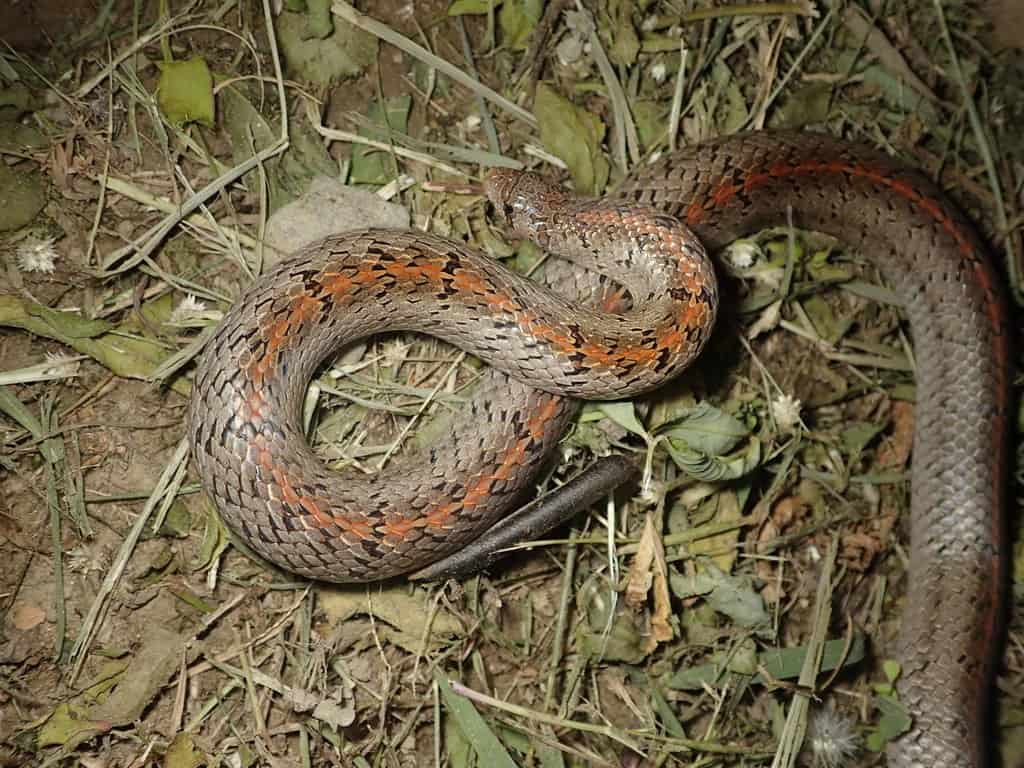
A non-venomous snake measuring 40-60cm, with a maximum of 95cm. This species inhabits southeast China, northern Laos and northern Vietnam, with Hong Kong and Taiwan being their main hotspots.
The Taiwan kukri snake (Oligodon formosanus) lives in forests, yet sticks primarily to the ground. They never appear in the bustling streets of Hong Kong, but are a regular sight in nature trails through forests. They vary significantly in appearance, as they’re normally some variation on brown, but with multiple unique morphs. Taiwan kukri snakes can be brown with an orange vertebral stripe, brown with a reddish tint, or light and dark brown in many intermingling shades.
Taiwan kukri snakes are perfectly harmless, as long as you don’t pick them up. This snake reaches an average of 50cm, yet is much more troublesome than the diamond-backed watersnake (over 1 metre). The Taiwan kukri snake has sharpened front teeth designed for hacking through calcified reptile eggs, but these double up as defensive tools.
This species can deliver several slashing bites to a human arm in rapid succession, making picking them up most unwise. If left alone, this species usually flees into the bushes. If you want to meet the Taiwan kukri snake, then dusk or early morning is the best time.
| 8 | Chinese slug snake |
A slow-moving snake which is constantly scanning the forest for slugs to swallow up. The Chinese slug snake (Pareas chinensis) not only climbs branches, but curls around them continuously as they slither, like a twisting piece of spaghetti. This snake measures 30-40cm (maximum 68cm) and cannot hurt humans, as they lack venom or even a sharp pair of teeth. They never bite, and their main strategy when flustered is to remain completely still, clinging to their tree branch.
Chinese slug snakes are a rare species in Hong Kong, as they’re mainly found in forests, near misty streams. They feed on snails and slugs exclusively, without even the occasional mouse or gecko snack. See this video for footage of one in motion.
Compared to the common slug snake (Pareas carinatus) of Thailand, this version has a higher amount of black bands. Chinese slug snakes have large eyes with a rich orange colour. They not only have black bands, but a smattering of black dots like a pepper shaker explosion.
Their weirdest physical feature is being translucent when held up to light. There’s no chance of confusing the Chinese slug snake for another snake nearby. Their relative the white-spotted slug snake also lives on Hong Kong, but this could never be confused, as it has a completely different colour scheme.
| 9 | Futsing wolf snake |
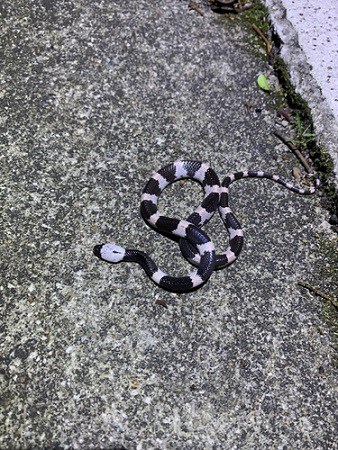
A species which isn’t rare in Hong Kong, but sticks to woods and forests away from urban areas. The Futsing wolf snake is non-venomous and reaches 80cm in the largest individuals. There’s endless wolf snakes in southeast Asia, but Lycodon futsingensis is recognisable by the white patch atop its head. Its face is extremely black, while the rest is black alternating against white.
If you see this snake in Hong Kong, then don’t approach! They’re perfectly harmless, and will normally flee for the bushes if humans wander past chatting. The reason to be cautious is a close resemblance to the deadly many-banded krait (Bungarus multicinctus), which also inhabits Hong Kong. The white and black bands are extremely difficult to distinguish for a beginner. It may not be a Futsing wolf snake you’re seeing at all. If in any doubt, stand well back.
This species normally moves slowly and carefully, not wanting to miss any scent particle clues. However, they can move rapidly if startled. Futsing wolf snakes mainly stick to the ground in forests, rather than climbing branches. A leafy forest floor is their favourite location of all. The white patches vary with this snake, as they can sometimes be darker, closer to gold in tone instead.
| 10 | Banded stream snake |
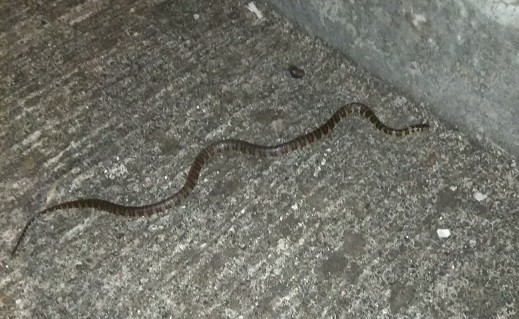
A relative of the diamond-backed watersnake. This version (Trimerodytes balteata) is easy to distinguish thanks to its vividly contrasting black and orange bands. On their belly, the orange vanishes and alternating black and white takes over.
The banded watersnake is a nimble dweller of freshwater habitats in Hong Kong, such as slow-moving rivers and wetlands. They rarely leave these water bodies, except after heavy downpours. Hence, they’re rarely seen by citizens of Hong Kong. Banded watersnakes are skilful in their watery realms, as they can probe into muddy shores, and even sift through submerged root systems to find the fish prey they’re specialised for.
You’d probably only meet Trimerodytes balteata if you fell face first into a marsh, and even then, they’re mostly harmless. Banded watersnakes will only bite if harassed, and the worst they do is produce a foul snake smell.
Banded watersnakes reach 40-60cm, with a maximum of 105cm, and have round pupils with virtually black eyes. They sometimes stray to land and rest on moist rocks amidst a nest of leaves. Up close, this is actually one of the most detailed snakes around, as there’s a constant speckle of neon orange covering their body, in the form of endless tiny dots and lines.
